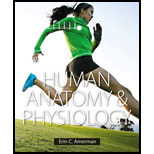
To review:
Whether the following statements are true or false. False statements are to be corrected.
a. The thirst mechanism is mediated by osmoreceptors located in the cerebral cortex.
b. The sensible water loss includes the water lost from the body via the skin and the respiratory system.
c. The main hormone that regulates fluid balance is antidiuretic hormone (ADH).
d. Atrial natriuretic peptide promotes water retention in the kidneys and increases the amount of water in the body.
e. Dehydration is characterized by a decreased volume and increasedosmolarity of the ECF.
Introduction:
The body fluids, electrolytes, acids, and bases play an important role in the human’s organ system. The amount of water in the ECF and in the human body is maintained by the organ’s function. Anyimbalance can cause a change in the osmolarity of the ECF.
Want to see the full answer?
Check out a sample textbook solution
Chapter 25 Solutions
Human Anatomy & Physiology
- 22. Which of the following mutant proteins is expected to have a dominant negative effect when over- expressed in normal cells? a. mutant PI3-kinase that lacks the SH2 domain but retains the kinase function b. mutant Grb2 protein that cannot bind to RTK c. mutant RTK that lacks the extracellular domain d. mutant PDK that has the PH domain but lost the kinase function e. all of the abovearrow_forwardWhat is the label ?arrow_forwardCan you described the image? Can you explain the question as well their answer and how to get to an answer to an problem like this?arrow_forward
- Describe the principle of homeostasis.arrow_forwardExplain how the hormones of the glands listed below travel around the body to target organs and tissues : Pituitary gland Hypothalamus Thyroid Parathyroid Adrenal Pineal Pancreas(islets of langerhans) Gonads (testes and ovaries) Placentaarrow_forwardWhat are the functions of the hormones produced in the glands listed below: Pituitary gland Hypothalamus Thyroid Parathyroid Adrenal Pineal Pancreas(islets of langerhans) Gonads (testes and ovaries) Placentaarrow_forward
 Biology (MindTap Course List)BiologyISBN:9781337392938Author:Eldra Solomon, Charles Martin, Diana W. Martin, Linda R. BergPublisher:Cengage Learning
Biology (MindTap Course List)BiologyISBN:9781337392938Author:Eldra Solomon, Charles Martin, Diana W. Martin, Linda R. BergPublisher:Cengage Learning





